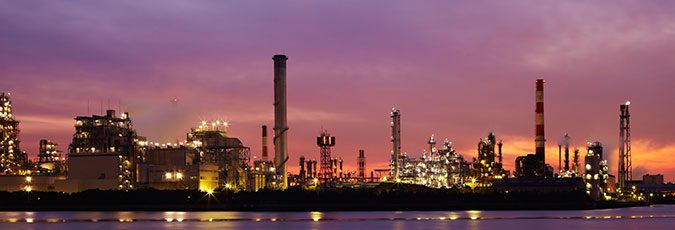Corrosion not only deteriorates materials, surfaces, and equipment, it eats into profits and productivity, and has an outsized impact on the bottom line of many industries, such as mining, various processing, and transportation. Fortunately, modern solutions exist to help you conquer corrosion and keep operations running smoothly and efficiently. There are many corrosion-resistant materials available, but fiber reinforced plastic (FRP) composites can deliver the optimum solution with outstanding structural performance and corrosion resistance for a broad range of industrial applications.
Impacts of corrosion on industry
A study regarding the overall impact of corrosion by NACE and CC Technologies pegged the annual cost in the United States alone at $276 billion. This figure was equivalent to 3.2 percent of GDP. The financial impact of corrosion in the production and manufacturing sector alone was estimated to be $17.6 billion annually. This sector includes industries like petroleum refining, mining, gasoline products, pulp and paper, chemicals, pharmaceuticals, and agriculture.
As an example, mining and related industries contend with elements that make for highly corrosive environments. The wide use of grinding materials, the presence of oxygen and water, large pH ranges, and microorganisms all add to the challenge of corrosion and its financial impact.
The World Corrosion Organization estimates global annual corrosion damage at $2.2-trillion USD, more than three percent of global GDP. Corrosion is a silent but very real enemy that eats away at productivity and profitability. Fortunately, there is a material available that offers real and measurable corrosion resistance: fiber-reinforced plastic (FRP) composites. The corrosion resistance of FRP is a solution with proven data behind it.
Most common types of materials and corrosion
There are many different types of corrosion. For instance, the appearance of corrosion is classified under various categories, including uniform (even across surfaces), pitting (creates a pit or cavity), crevice (inside crevices or concealed areas), stress corrosion (cracks), or inter-granular (localized at metal grain boundaries).
Here are a few of the most common mechanisms that can cause materials to corrode under regular use.
- Atmospheric corrosion: one of the most common types of corrosion, i.e. rust on iron, a result of oxygen and water vapor interacting in the environment.
- High temperature corrosion: a natural process where metal is converted to an oxide. Can take the form of oxidation, sulfidation, ash or salt deposits, molten salt corrosion, metal dusting, or carburization.
- Microbial corrosion: aerobic or anaerobic activity of microorganisms on surfaces can cause various types of corrosive damage.
What is corrosion resistance?
Corrosion is a natural process in which a material becomes oxidized by substances in the surrounding environment which cause the material to lose electrons. Corrosion resistance is the characteristic of a material to maintain the binding energy of the material (such as metal or FRP composite) and withstand the deterioration which would otherwise occur by exposure to its environment and applications.
According to Science Direct, corrosion resistance is “the parameter that describes the deterioration of intrinsic properties of a material caused by reaction with surrounding environments.” Put simply, corrosion resistance is the measure of how well a material offers protection against adverse reactions that can corrode it. Different materials have different intrinsic properties of corrosion resistance. Varying methods or treatments can also be used to resist corrosion, depending on the material, such as painting, hot dip galvanizing, or other types of coating.
Examples of corrosion-resistant materials
Some traditional materials are more resistant to corrosion than others, and many are in common use throughout the industry as well as in consumer applications. These include stainless and galvanized steel, aluminum, copper, bronze, brass, and more. All of these materials have seen wide-ranging use throughout history, are commonly available, and solutions for almost any application are well supported by manufacturers and materials providers.
However, industrial applications often require very huge amounts of materials, such as miles of steel pipe, copper wire, or aluminum paneling, which can become cost-prohibitive under some situations. FRP building products and FRP composites provide an economical alternative to metal-based solutions for industrial environments, along with the unique corrosion resistance of fiberglass properties.
Advantages of FRP composites for corrosion resistance
In mineral refining associated with mining and other process industries, FRP composites offer a service life of 35+ years in many applications. These composite materials also provide similar benefits to numerous other industries, including:
- Pulp and paper
- Oil and gas
- Chemical processing
- Power generation
- Desalination
- Wastewater
Corrosion can take on many forms. In mining, abrasion is a common cause of corrosion. With milling processes requiring pipe and pumping systems that are especially vulnerable to abrasion-induced corrosion, FRP brings a solution to particulate abrasion and/or erosion. Traditional pump systems and piping that use metal often suffer from abrasive particulates wearing down the protective film on the metal surfaces. Once this film is compromised, reactive metal alloys can quickly break down and corrode. Custom FRP products and nonmetallic solutions can be specially formulated to address uniquely demanding environments.
Wire rope, roof bolts, pump and piping systems, electronics, and acidic drainage systems are all inhospitable environments for metals that can corrode. Traditionally, various FRP solutions have been employed, including the use of corrosion inhibitors, protective coatings, and electrochemical cathodic protection. However, these are relatively short-term fixes compared to the decades-long protection that FRP offers.
Corrosion resistance with FRP composites is the long-term answer for challenging environments
FRP also contributes a host of other advantages, including a high strength-to-weight ratio, superior durability, and dimensional stability. FRP composites can be used in new designs, material upgrades, and customized components.
For more information about how FRP composites can address your industry-specific challenges and enhance your profitability, please contact a representative.

